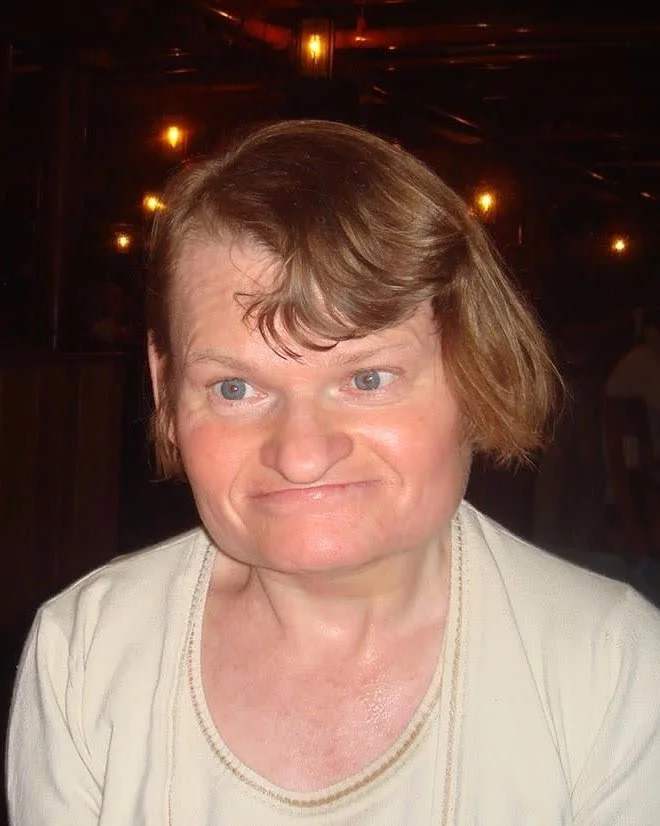Lynn Parker
Lynn’s story
Lynn was 64 years old, and had a learning disability, osteoporosis and kyphoscoliosis. She was a wheelchair user and while she was non-verbal she expressed herself through sounds and body language. She lived in a residential care home which was close to her sister.
She was injured at home when was dropped from a height of 1.5 metres while being hoisted from her wheelchair to her bed by two carers employed by the home. They called for an ambulance but did not convey the severity of the injury or the height of the fall, and the 999 call handler failed to ask triage questions about her pulse, temperature and pain level. Lynn was clearly in distress (as recordings of the phone call demonstrated). However, she was categorised as a non-urgent call and she lay on her bedroom floor for 3 hours. Lynn’s breathing worsened and her carers called 999 again asking when an ambulance would arrive, and this time the call handler asked them to check her oxygen stats. After discovering her low oxygen levels, she was changed to a category 1 (emergency) call. The paramedic team arrived within quarter of an hour and decided she needed to go to hospital. Unacceptably Lynn was conveyed on her own with no one from the care home travelling with her or meeting her at the hospital. They did send her in with her Passport.
She should have had someone attend hospital with her, as she was vulnerable, non-verbal and lacked capacity.
Upon arriving at the emergency department there was a poor information handover between the ambulance team and the emergency department, and then the triaging nurse entered incorrect information about Lynn including her age and the details of Lynn’s fall. Given no-one was there to explain what had happened the misinformation was never corrected. It was by now Friday evening so no learning disability nurse was available when Lynn went into hospital, as the nurse was only employed 9-5 on weekdays.
A number of appalling errors were made by the assessing A&E doctor, a consultant in emergency medicine. He did not complete a physical examination. He put in the notes that Lynn was combative upon examination, and as a result he was only able to visually assess her (Lynn was tiny of build) to explain this deficiency and because he could see her right arm was at an angle he realised she needed an x-ray on her right arm. The x-ray showed that she had a broken right arm. However, she also had a broken left arm and broken ribs. He ordered her discharge without having done a proper examination, and without considering safeguarding considerations given the nature of her injury and how it had occurred. This was a complete failure of care. It is important to note that the Inquest that was later heard into the cause of her death found that these failures did not cause Lynn’s death, but without a doubt they contributed to her pain and suffering and in another patient could had being a contributory cause.
She arrived back home around midnight without a discharge letter so that the carers had no idea how to manage her care and it is likely that the pain from the broken arms and ribs caused her excruciating pain during the night and affected her ability to breath. Early the next morning when a new carer came onto their shift that they noticed swelling and bruising of Lynn’s left side and that she was really unwell. They called an ambulance that came quickly this time. Lynn was then taken back to the emergency department with a new team on shift, where a CT scan revealed further fractures to Lynn’s left arm and two ribs. She had also contracted aspiration pneumonia, as her pre-existing mobility needs were compounded by the fractured and untreated ribs; meaning she had reduced chest movements to breathe properly.
When determining how to best treat Lynn, hospital staff inappropriately applied the clinical frailty score to Lynn and limited the care that she would receive to treat the infection. Furthermore, the team imposed a DNACPR on Lynn without discussion with her family, or input from the learning disability nurse. Kim, Lynn’s sister, had to fight hard to have this DNACPR lifted and to get Lynn receiving a course of antibiotics. The hospital maintained their refusal to treat Lynn in an intensive care unit, and she later died in hospital of her injuries.
The Inquest
After receiving this case through the Mencap Helpline, Caron Heyes of Fieldfisher took this case on pro bono. Rachel Troup of 39 Essex Chambers represented Lynn’s sister Kim pro bono at the inquest, which lasted for 4 days.
The inquest heard how Lynn’s fall from the hoist occurred because she was not properly secured to the bars it was fixed to, and that the carers moving and handling training was out of date. In addition, the inquest heard that there was a failing to place Lynn on a trauma pathway once she had arrived at the emergency department as the staff were not fully aware of the extent of the fall. Furthermore, evidence from the inquest highlighted how the hospital staff failed properly safeguard Lynn upon her hospital discharge in light of her injuries and underlying mobility issues. They also had failed to consider how Lynn had come to be injured, and that she would be discharged back into the care of the same people.
The care home were questioned on their staff training policies and procedures around managing acute incidents when interacting with emergency services. Likewise, the care home were questioned on whether they had a policy on accompanying residents to hospital to ensure that residents do not go without an advocate.
The coroner directed the jury that they were not to return a verdict of neglect, and were limited to an accidental or narrative conclusion. Furthermore, the coroner directed the jury that they were not able to find failings in the care Lynn received from the ambulance or the hospital.
The jury returned a narrative verdict to summarise the circumstances of her death in light of the fall and her pre-existing conditions.
What can be learned?
Lynn’s case highlights how failings in care can become apparent when non-verbal patients are not properly advocated for, and for when there are communication breakdowns between care teams. Likewise, this case shows how the inclusion of a learning disability team, or lack thereof, can influence the care that people like Lynn receive.
The issue of death certification is a really important one. Lynn’s certificate stated that her LD had contributed to her death. We had to argue at the inquest that it was not appropriate to state this unless the coroner was stating that a failure to accommodate the LD had contributed to her death. LD in itself can never be a cause of death. We were successful in persuading the Coroner to change the death certificate.
The next month at a health summit convened by Mencap at which MAnada prtichard head of NHSE spoken Caron Heyes raised Lynn’s case as an example of this problem Mencap and RV see recurring of LD being put as a cause of death on certificates. we continue to campaign for a change in the national medical guidance around how death certs should be completed as it is our aim to never have LD as a cause of death unless it has been noted on the DC that LD contributed to the death because of a failure to accommodate LD needs.
When talking to media about Lynn’s inquest, Kim said:
“Lynn was a victim of a catalogue of catastrophic failures and I just feel that what happened in the care home and what happened in the emergency department… her failure to be correctly triaged and diagnosed is still quite hard for me to take in.”
“It’s devastating to think what Lyn suffered being dropped and hurt by the carers she trusted most at (the) care home, and then left to go to hospital on her own. These terrible failings must not be forgotten or glossed over, and promises kept that things will improve. They have to, or Lynn will simply become another statistic, and that would be unbearable.”
Caron Heyes, who represented Kim at the inquest, said in her media statement that:
“Lynn was the tragic victim of catastrophic failures of care that were simply not acceptable and caused her avoidable death. We cannot go on and on hearing about failures to protect people with learning disabilities from avoidable errors in care. It is up to the institutions involved to listen, learn and to keep their promises to ensure people in their care are safe.”
[Mencap - Dan?] said that this case demonstrates…..
Following the inquest, Caron and Dan met with the Kingston NHS Trust learning disability team to talk about the safety points which had been raised to prevent future deaths of people with a learning disability happening in their care.
We are also discussing with various bodies the revision of guidances on the completion of death certifications.
-
Press reports Lynn Parker Inquest following narrative verdict I Fieldfisher
Woman died after being dropped in care - inquest I BBC
Jury out at inquest into death of disabled woman dropped by care home workers I Independent
Disabled woman died days after being dropped by care home workers, inquest told I ITV News
Sister of disabled woman dropped by carers ‘feels sense of betrayal and anger’ I ITV News

